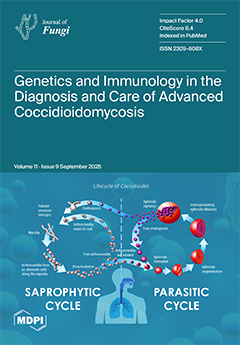Species of
Trichoderma are currently in high demand as eco-friendly and commercial biocontrol agents due to the proliferation of organic farming methods. This study focused on the potential biocontrol agents of
Trichoderma against plant-pathogenic fungi.
Trichoderma strains were isolated from different sources (soil,
[...] Read more.
Species of
Trichoderma are currently in high demand as eco-friendly and commercial biocontrol agents due to the proliferation of organic farming methods. This study focused on the potential biocontrol agents of
Trichoderma against plant-pathogenic fungi.
Trichoderma strains were isolated from different sources (soil, grapevine tissues, lemon fruit, and maize seeds), and were characterized morphologically on two culture media, i.e., Potato Dextrose Agar and Malt Extract Agar, and molecularly using two gene regions: translation elongation factor 1 (TEF) and nuclear ribosomal internal transcribed spacer (ITS). Phylogenetic trees were constructed. As a result, two
Trichoderma species were identified, i.e.,
T. afroharzianum and
T. longibrachiatum. The biocontrol effects of all isolated strains of
Trichoderma on
Fusarium plant damping-off and the promotion of plant growth were evaluated. Additionally, the antagonistic efficiency of
Trichoderma spp. against
F.
proliferatum using the dual-culture method was evaluated. Under greenhouse conditions,
T.
afroharzianum strains AEMCTa3 and AEMCTa6 were used to treat maize plants infected with
Fusarium. The application of
Trichoderma significantly reduced the disease index to 15.6% and 0%, respectively. Additionally, maize seedlings showed significant improvements in shoot and root lengths and fresh and dry weights and increased photosynthetic pigment contents compared to
Fusarium-infected plants and the untreated control. The gas chromatography–mass spectrometry (GC-MS) analysis of
T. afroharzianum extracts identified a variety of bioactive compounds. These compounds included antifungal substances like N-ethyl-1,3-dithioisoindoline, as well as plant growth-promoting hormones like 6-pentyl-α-pyrone and gibberellic acid. Interestingly, the analysis also revealed new phenylacetic acid derivatives that may play important roles in both plant health and disease resistance. From a practical perspective, developing diverse application methods for
Trichoderma is essential to optimize its role as a biocontrol agent and a plant growth promoter, thereby supporting sustainable agriculture through improved adaptability and effectiveness across different farming systems.
Full article






